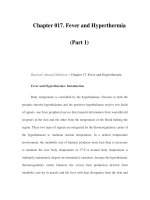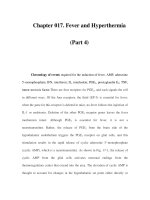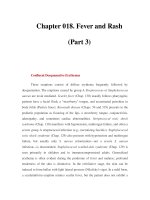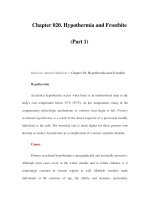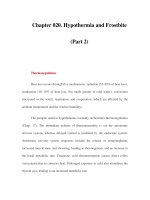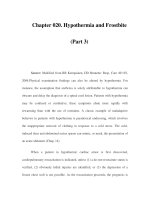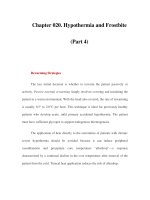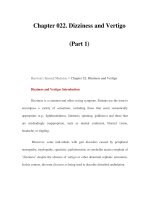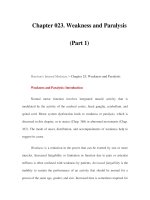Chapter 020. Hypothermia and Frostbite (Part 1) potx
Bạn đang xem bản rút gọn của tài liệu. Xem và tải ngay bản đầy đủ của tài liệu tại đây (15.25 KB, 6 trang )
Chapter 020. Hypothermia and Frostbite
(Part 1)
Harrison's Internal Medicine > Chapter 20. Hypothermia and Frostbite
Hypothermia
Accidental hypothermia occurs when there is an unintentional drop in the
body's core temperature below 35°C (95°F). At this temperature, many of the
compensatory physiologic mechanisms to conserve heat begin to fail. Primary
accidental hypothermia is a result of the direct exposure of a previously healthy
individual to the cold. The mortality rate is much higher for those patients who
develop secondary hypothermia as a complication of a serious systemic disorder.
Causes
Primary accidental hypothermia is geographically and seasonally pervasive.
Although most cases occur in the winter months and in colder climates, it is
surprisingly common in warmer regions as well. Multiple variables make
individuals at the extremes of age, the elderly and neonates, particularly
vulnerable to hypothermia (Table 20-1). The elderly have diminished thermal
perception and are more susceptible to immobility, malnutrition, and systemic
illnesses that interfere with heat generation or conservation. Dementia, psychiatric
illness, and socioeconomic factors often compound these problems by impeding
adequate measures to prevent hypothermia. Neonates have high rates of heat loss
because of their increased surface-to-mass ratio and their lack of effective
shivering and adaptive behavioral responses. In addition, malnutrition can
contribute to heat loss because of diminished subcutaneous fat and because of
depleted energy stores used for thermogenesis.
Table 20-1 Risk Factors for Hypothermia
Age extremes Endocrine-related
Elderly Diabetes mellitus
Neonates Hypoglycemia
Environmental exposure Hypothyroidism
Occupational Adrenal insufficiency
Sports-related Hypopituitarism
Inadequate clothing Neurologic-related
Immersion Cerebrovascular accident
Toxicologic &
pharmacologic
Hypothalamic disorders
Ethanol Parkinson's disease
Phenothiazines Spinal cord injury
Barbiturates Multisystem
Carcinomatosis Trauma
Anesthetics Sepsis
Neuromuscular blockers Shock
Antidepressants Hepatic or renal failure
Insufficient fuel Burns and exfoliative dermatologic
disorders
Malnutrition Immobility or debilitation
Marasmus
Kwashiorkor
Individuals whose occupations or hobbies entail extensive exposure to cold
weather are at increased risk for hypothermia. Military history is replete with
hypothermic tragedies. Hunters, sailors, skiers, and climbers also are at great risk
of exposure, whether it involves injury, changes in weather, or lack of
preparedness.
Ethanol causes vasodilatation (which increases heat loss), reduces
thermogenesis and gluconeogenesis, and may impair judgment or lead to
obtundation. Phenothiazines, barbiturates, benzodiazepines, cyclic antidepressants,
and many other medications reduce centrally mediated vasoconstriction. Up to
25% of patients admitted to an intensive care unit because of drug overdose are
hypothermic. Anesthetics can block the shivering responses; their effects are
compounded when patients are not covered adequately in the operating or
recovery rooms.
Several types of endocrine dysfunction can lead to hypothermia.
Hypothyroidism—particularly when extreme, as in myxedema coma—reduces the
metabolic rate and impairs thermogenesis and behavioral responses. Adrenal
insufficiency and hypopituitarism also increase susceptibility to hypothermia.
Hypoglycemia, most commonly caused by insulin or oral hypoglycemic drugs, is
associated with hypothermia, in part the result of neuroglycopenic effects on
hypothalamic function. Increased osmolality and metabolic derangements
associated with uremia, diabetic ketoacidosis, and lactic acidosis can lead to
altered hypothalamic thermoregulation.
Neurologic injury from trauma, cerebrovascular accident, subarachnoid
hemorrhage, or hypothalamic lesions increases susceptibility to hypothermia.
Agenesis of the corpus callosum, or Shapiro syndrome, is one cause of episodic
hypothermia, characterized by profuse perspiration followed by a rapid fall in
temperature. Acute spinal cord injury disrupts the autonomic pathways that lead to
shivering and prevents cold-induced reflex vasoconstrictive responses.
Hypothermia associated with sepsis is a poor prognostic sign. Hepatic
failure causes decreased glycogen stores and gluconeogenesis, as well as a
diminished shivering response. In acute myocardial infarction associated with low
cardiac output, hypothermia may be reversed after adequate resuscitation. With
extensive burns, psoriasis, erythrodermas, and other skin diseases, increased
peripheral blood flow leads to excessive heat loss.
